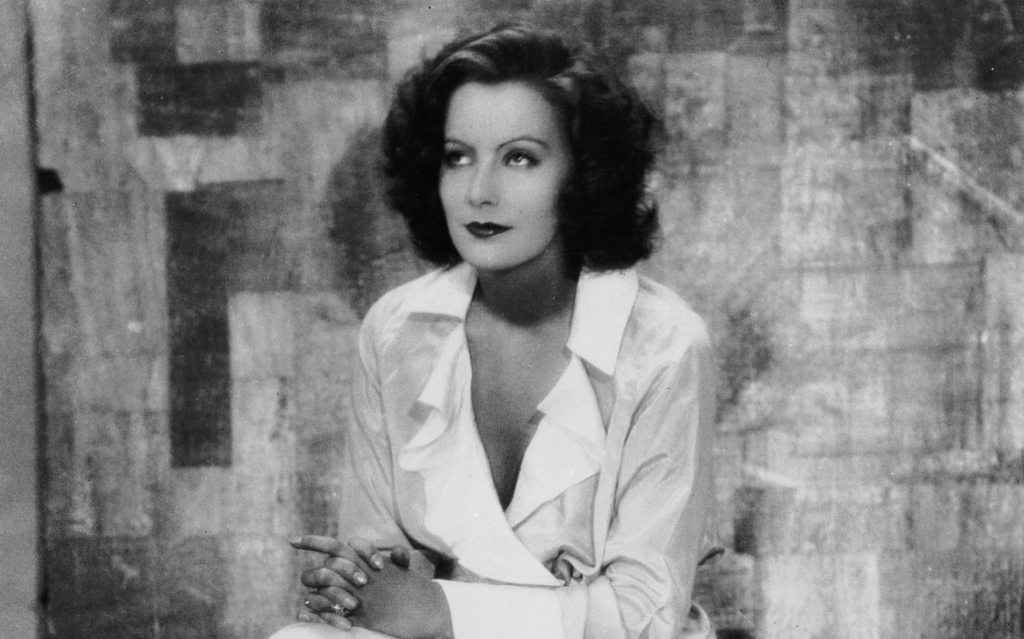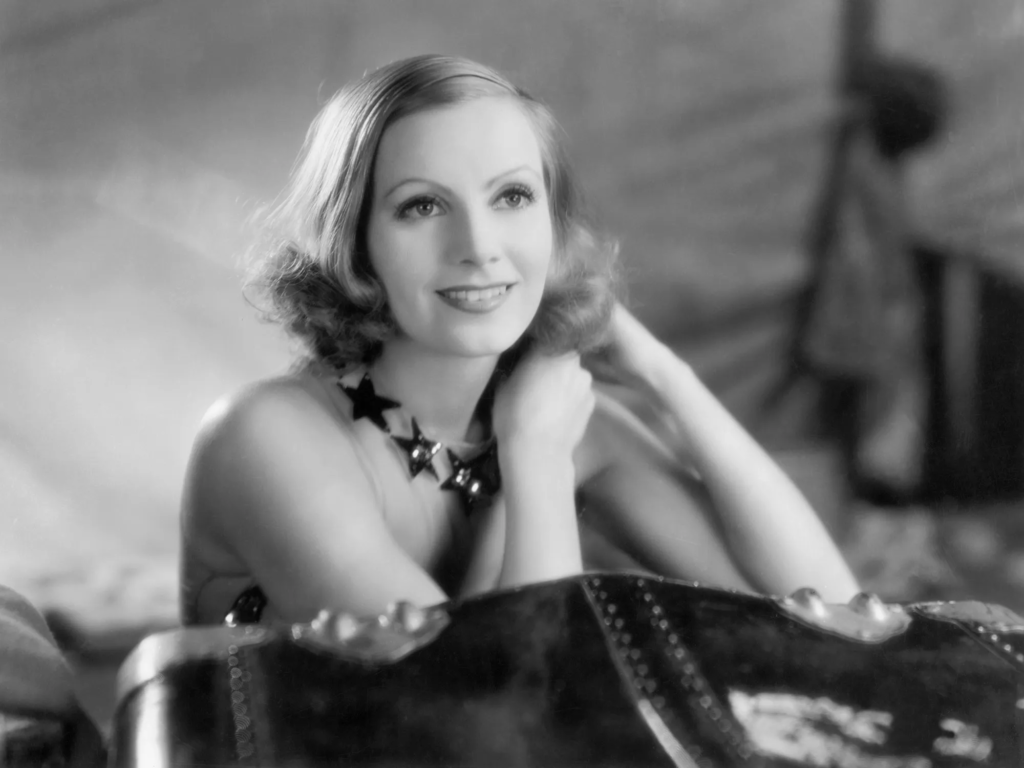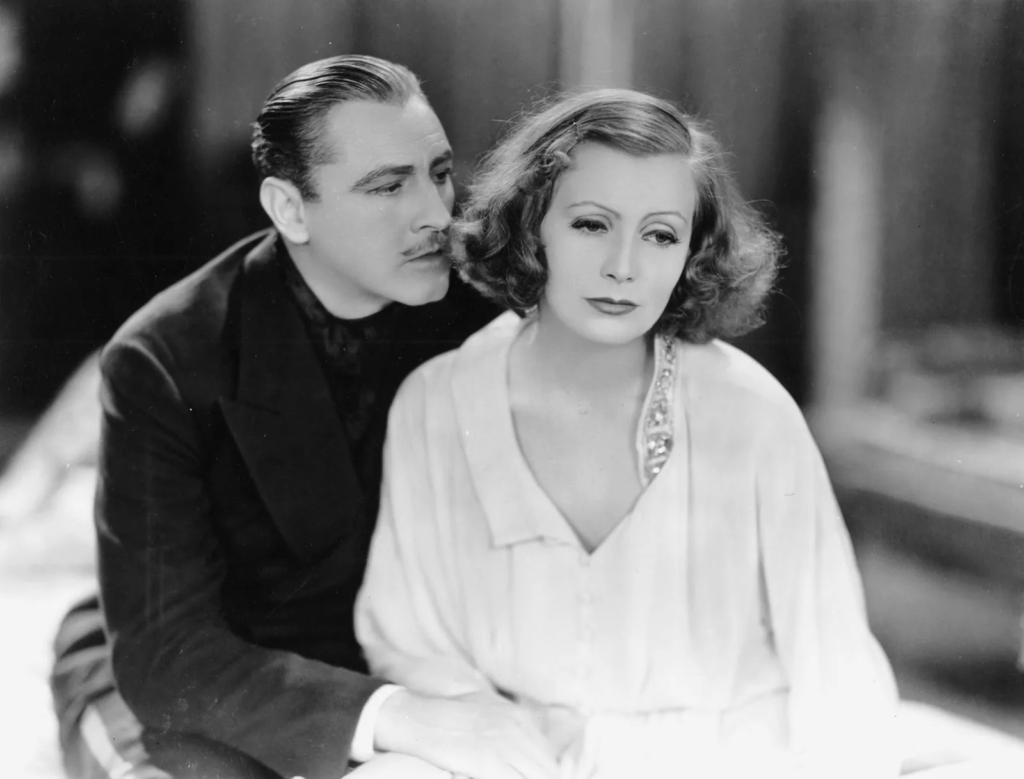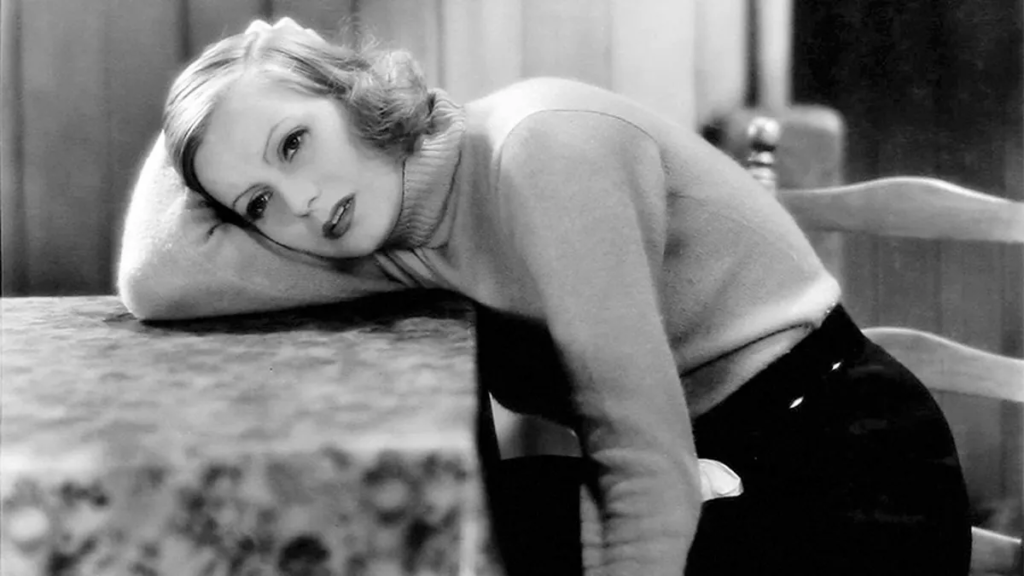“Garbo still belongs to that moment in cinema when capturing the human face still plunged audiences into the deepest ecstasy, when one literally lost oneself in a human image as one would in a philtre, when the face represented a kind of absolute state of the flesh, which could be neither reached nor renounced.”

Greta Garbo used to be really, really famous. That’s something that us modern consumers of celebrity can’t really understand anymore. A lot of people are famous now, and fame doesn’t really seem that hard to come by. For an actress whose career lasted from the last years of the silent era to just before the US entered WWII, Greta Garbo made a relatively small number of films in Hollywood while other actor’s film performances sometimes numbered in the hundreds She was also known to be fiercely private, even by the standards of the era. I think it is because of this wanted privacy and because of her relatively scarce film output that made her as big a mega-star as she was. Absence, Garbo proved, does make the heart grow fonder. Regardless of her wishes to remain private, her face (and what a face it was) was everywhere.
Garbo’s legendary loneliness started at a young age as a child in Stockholm, as she recalled: “It was eternally grey—those long winter’s nights. My father would be sitting in a corner, scribbling figures on a newspaper. On the other side of the room, my mother is repairing ragged old clothes, sighing. We children would be talking in very low voices, or just sitting silently.” In public and in private, Garbo always spoke with a sort of melancholy. At the time, this made her seem more mysterious and attractive. Now, we would likely recognize this to be a manifestation of depression. She participated in local theatre as a child, worked as a fashion model, and appeared in some commercials. In an interview with Orson Welles by Jack Parkinson, the two begin reflecting on the lost days of Hollywood stardom. Parkinson asks Welles: “Either the camera loves you or the camera doesn’t. I presume that was more true about Garbo than anybody else?”. Welles agrees, then brings up a handful of Garbo’s early commercials he had seen while touring the Swedish Film Institute:
“There was this great galumphing ‘Swedish cow’ having a picnic. There was NOTHING to show you that you were looking at the most divine creature who would ever be on the screen. And two years later she was Greta Garbo.”

Though I don’t subscribe to such degrading terminology, I too admit that there is a vast difference between her appearance in these commercials compared to even her earliest film performances.
Greta would go on to study at the Swedish Royal Dramatic Training Academy. Super fans may recognize this as the period during which she developed a close relationship with fellow actress Mimi Pollak. Garbo’s bisexuality (or something of the like), about which much has been speculated, appears to have at least a semblance of truth within the letters written between these two friends. Upon hearing of Pollak’s pregnancy, Garbo wrote: “We cannot help our nature, as God has created it. But I have always thought you and I belonged together.”
At only 19, Garbo was recruited by Finnish director Mauritz Stiller to appear as the lead of her first film, The Saga of Gösta Berling. This was soon followed up by a leading role in G.W. Pabst’s The Joyless Street, a controversial and highly censored film about prostitution, theft, murder, and all sorts of unsavory characters suffering from post-war poverty. Somehow (there are several stories) she gained the attention of MGM Dictator Perpetuo Louis B. Mayer who brought her to Hollywood and signed her to a studio contract. It didn’t take long for a star to be born.
Garbo arrived in Hollywood during the tail end of Silent Era Hollywood, which was all the same to her because she didn’t speak english. At the time, “foreignness” was an asset for stars, who used their exotic beauty, style, and often manufactured backstories to their advantage. Garbo was heralded in the style of European-born stars like Alla Nazimova and Pola Negri. Though such comparisons are obvious, I am more likely to compare her to Rudolph Valentino, who would die the same year Garbo made her first Hollywood movie. Literary theorist Roland Barthes makes the same comparison:
“A few years earlier the face of Valentino was causing suicides; that of Garbo still partakes of the same rule of Courtly Love, where the flesh gives rise to mystical feelings of perdition.”

Valentino was the original Latin Lover, and used his exotic charm in such a way that caused fainting spells and hysteria amongst his fans. Yet there was something obscurely feminine about him, in his grace and passion on screen. I wonder if, conversely, Garbo was so attractive to male audiences not in spite of her masculinity, but because of it. If she was something of a taboo to heterosexual men, and therefore all the more exciting and desirable.
Though such language would be used in this manner at the time, audiences of the 1930s could probably tell there was something “queer” about her – in her face, in the way she dressed and walked, in the roles she played – she was not inherently feminine, not sweet like Mary Pickford or glamorous like Gloria Swanson. Garbo almost seemed unfettered by the nonsense of gender. “The androgyne is certainly one of the great images of Camp sensibility” writes Susan Sontag, referring specifically to “the haunting androgynous vacancy behind the perfect beauty of Greta Garbo”. In her face, frame, and style, Garbo personified art deco.
Garbo’s career was fast tracked when she became associated with Jack Gilbert, at the time one of the most popular leading men in Hollywood. Unfortunately, the outcome of their relationship would turn out like a messier version of A Star is Born. While Garbo succeeded in the early days of talking pictures, Gilbert’s career became less and less stable. The reasons for Gilbert’s downfall are as varied as any Hollywood legend: Maybe it was because spoke with a distinct diction trained for the theatre that just didn’t work in the movies; maybe it was because he was an alcoholic; maybe it was the result of a personal vendetta by Mayer. Probably, it was a bit of all three. Gilbert and Garbo’s three silent film pairings were all hits, capitalizing on their rumored off screen love affair. The legitimacy of this relationship is up for debate, as it lacks no concrete proof beyond studio publicity rags. One story states that the two planned to be married in a double wedding ceremony alongside King Vidor and Eleanor Boardman, but Garbo got cold feet and left Gilbert at the altar. There was a relationship there, that’s for certain. What we don’t know is exactly what sort of relationship it was.
When Gilbert’s career was in significant decline, Garbo did him a solid by having him cast as her romantic lead in Queen Christina, an eerily true-to-life piece that stands as a pillar of early queer cinema. The film is a fictionalized account of the final years of the reign of Queen Christina of Sweden in the 17th century. Christina was known to be a highly-educated woman who sought to make Stockholm the “Athens of the North”. While queen, she lived an unconventional lifestyle for a woman of her time, notably dressing mostly in men’s attire. At 28, she decided to convert to catholicism and abdicate her throne. She never married, and spent the rest of her life traveling around Europe. In Queen Christina, the queen’s interest in the catholic religion is replaced by her love for a catholic man, a Spanish courtier played by Jack Gilbert. In real life, Christina was known to have a close relationship with one of her ladies in waiting, a relationship which is not-so-subtly alluded to in the film with a kiss and a wink. Garbo spends the first half of the film in male-attire, looking perhaps as beautiful as she ever did. She meets the Spanish courtier in this attire, and he mistakes her for a man. Thus, they share a room together at an inn. When the Spaniard realizes that Christina is a woman, his attraction turns from one of camaraderie to one of lust. In a love scene typical of the early 1930’s, the chemistry between the two is palpable. Still in her masculine attire, the scene possesses a paradoxical sense of homoeroticism, as if a love scene between two men, further twisting the film’s somewhat radical portrayal of gender and sexuality.

This was only one of many love scenes between Garbo and her male co-stars throughout her filmography that appear, in their staging and dialogue, to be a little “queer”. Physically, she’s often in the dominant position, holding the man’s face in her hands, and instigating every kiss and movement. In a 1930 Photoplay article titled “The Private Life of Greta Garbo”, there are numerous references to her masculinity, and her bachelorhood:
“She wore men’s tailored shirts. She owned dozens of men’s silk ties, in all colors. At night, she wore men’s pajamas, in soft shades of silk and in stripes. Her hats were of soft felt in mannish style. . . When her manservant brought her shoes, she would laugh and say, ‘Just the kind for us bachelors, eh?'”
Some of the lines in the article may seem unremarkable to the untrained eye, but stick out to a certain few:
“In the summer of 1929, Garbo did not seem to be devoted to any particular man.”
“Garbo has always been fond of flowers. Her favorites are pansies and violets.”
Maybe I’m reading too deeply into this, but something about these particular terms reads as tongue in cheek, as if perhaps it was an open secret that Greta was a little “different” from the other girls. During this time period, queer moviegoers had to look for these sorts of subtleties wherever they could so that they might have something, and someone, to identify with. How did her queer fans see her? Did they recognize something in her that others didn’t?
Queen Christina concludes in a fashion that is eerily similar to the real life scenarios of Garbo and Gilbert. Woman is a ruler, woman falls in love with a man, man dies, woman loses interest in the whole thing and gives up the crown. Three years after Queen Christina, Jack Gilbert was dead from a heart attack brought on by severe alcoholism. Garbo was not in attendance at his funeral. Garbo would go on to make six more films, including some classic costume period dramatic romances, and arguably her greatest and most iconic role: Ninotchka. This was Garbo’s first proper comedy, written by Billy Wilder and directed by Ernst Lubitsch. The marketing for the film capitalized on Garbo’s melancholic and dramatic persona, with the film’s posters proudly proclaiming “Garbo laughs!” She’s sensational in it, totally mastering her comedic timing and deadpan humor with the sophistication of “The Lubitsch Touch”.
In 1941, Garbo starred in her last film: Two Faced Woman, a comedy with a plot akin to The Lady Eve. The film was a box office and commercial failure, and Garbo and MGM came to a mutual agreement to not renew her contract at the studio. And that was it. I don’t believe that one bad box office performance was the cause for her retirement. I think she was sick of the whole thing, as she’d likely been for several years.
When she retired in 1941, that enigmatic “face of the century” became an even more rare and valuable find. In 1949, she did a screen test for a Max Ophüls adaptation of a Balzac novel, which can be viewed on Youtube. If this footage had been publicly available in 1949, her face would have been very different to audiences who remembered her from the 1930s, but certainly no less beautiful. That once smooth face is marked by laugh-lines and crow’s feet. She looks, perhaps for the first time ever on film, to be genuinely happy. But financing fell through, and the screen test never amounted to a real film. I can’t help but play out the scenario in my head of how different her legacy would be if the film had come to be. Would she have had a second career in European film? Would she have been cast as Norma Desmond in Sunset Boulevard, as Wilder had initially intended, and been introduced to an entirely new generation of filmgoers? Maybe. But she didn’t, and from there, she essentially vanished. Or at least, she tried to.
“There just aren’t any faces like that anymore. Maybe one – Garbo.”

Like spotting Bigfoot (an apt comparison considering how she was often characterized by and teased about her supposedly large foot size) the act of Garbo-spotting became a niche pastime of in-the-know New Yorkers. Many would have their stories of “that time” they swear they saw her on a walk in Central Park, or in an expensive clothing store. She moved through the city like an apparition, only visible in a particular light, at a certain angle. The sight of her was overwhelming, halting onlookers in their tracks while leading to twisted tongues and fumbling fingers. There are many photos of her in this transient, almost ephemeral state. She moves about like a rare animal evading capture from a wildlife photographer. Today, I despise the selfish ways in which fans flock actors and singers in public spaces for pictures, totally disregarding that they are, in fact, human. But I can’t blame those who approached Garbo in awe, if you had the wherewithal to do so. If I had the opportunity myself, I would have done the same thing. To some, it would have been like encountering a saint, a sight that thrusts worshippers into a state of rapture. To her, it was a mere disturbance, a memory of a time in her life she was happy to let go of. Obviously, on screen and in real life, before, during, and after stardom, she very much wanted to be left alone.





